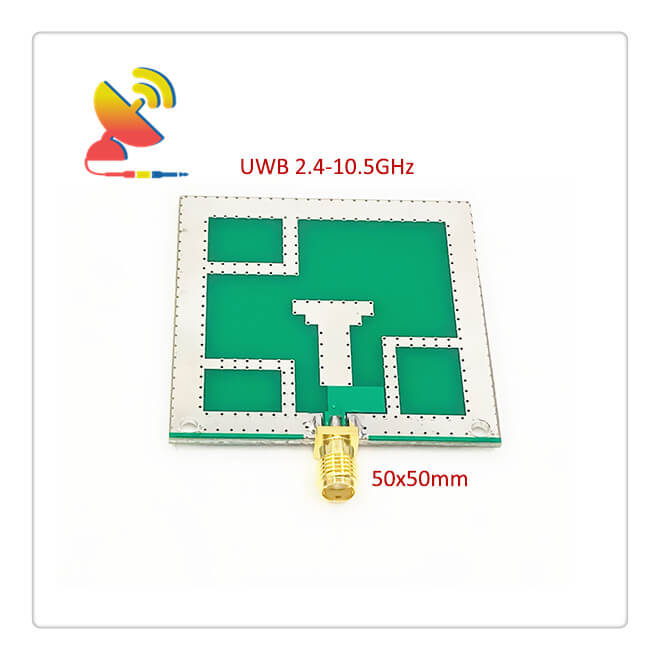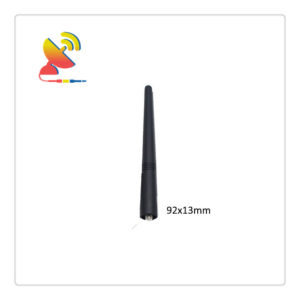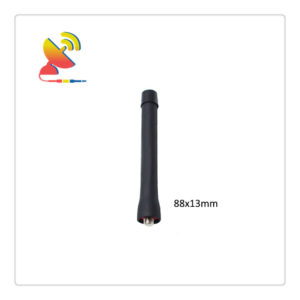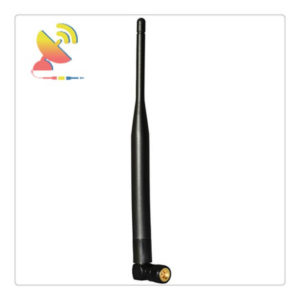Description
What is a 2.4-10.5 GHz Wireless Application UWB Antenna PCB Patch Antenna?
The CTRF-ANTENNA-PCB-2401050-5050-SMA is a UWB antenna PCB trace antenna with an extra-wide band 2.4GHz-10.5GHz patch antenna SMA female connector high-gain antenna manufactured by C&T RF Antennas Inc.
The UWB Antenna PCB Antenna is a patch antenna with a 50x50mm PCB board size, female SMA connector, and a 6dBi/8dBi high-gain, ultra-wideband 2.4GHz-10.5GHz frequency.
2.4-10.5 GHz Wireless Application UWB Antenna PCB Patch Antenna Is Available At C&T RF Antennas Inc. The leading ultra wide-band antenna indoor-outdoor UWB antenna manufacturer in China.
C&T RF Antennas Inc provides internal & external antennas with antenna radio frequencies such as NFC, 169MHz, 230MHz, 315MHz, 433MHz, 868MHz, 915MHz, VHF&UHF, Lora, NB-IoT, ADS-B, GSM, GNSS, GPRS, 1.2 GHz, 1.4 GHz, 1.8 GHz, Wi-Fi 2.4 GHz, 5.8 GHz, Cellular 2G, 3G, 3.5 GHz, 4G LTE, GPS, 5G NR, 6G, etc.
C&T RF Antennas Inc. provides RF antennae with Omni & Directional antenna types such as Dipole Antennas, Whip Antennas, Marine Antennas, Router Antennas, MIMO Antennas, Combo Antennas, PCB Antennas, FPC Antennas, Spring Antennas, Magnetic Antennas, Sector Antennas, Yagi Antennas, and Accessories, etc, for IoT & M2M industries.
Contact Us For More Info of UWB antenna PCB antennas details such as UWB Antenna PCB datasheet, UWB Antenna PCB pricing, UWB Antenna PCB inventory, etc.
2.4-10.5 GHz UWB Antenna PCB Antenna Specifications
2.4-10.5 GHz UWB Antenna PCB Antenna Electrical Specifications |
|
| RF Antenna Type | UWB Antenna PCB Antenna |
| Model | CTRF-ANTENNA-PCB-2401050-5050-SMA |
| Frequency | 2.4GHz-10.5GHz |
| Gain | 6dBi/8dBi |
| VSWR | ≤3.0 |
| Impedance | 50 Ω |
| Polarization | Vertical/Linear |
| Connector | SMA Female |
| Lightning Protection | DC-Ground |
2.4-10.5 GHz UWB Antenna PCB Antenna Mechanical Specifications |
|
| PCB Board Dimension | 50*50mm |
| Weight | Approx. 10g |
| Material | PCB Board |
| Operation Temperature | -40˚C ~ +75˚C |
| Storage Temperature | -40˚C ~ +80˚C |
| Color | Green |
| Antenna Design | Dipole Antenna |
| Mounting | Screw |
| Safety Emission and other | RoHS Compliant |
Ultra-Wide Band Technology
UWB (Ultra-Wide Band) is a wireless technology that transmits data at a high speed over a short distance with very low power.
This technology, originally used exclusively by the military, has attracted worldwide attention since the Federal Communications Commission (FCC) officially approved it for civilian use in February 2002. UWB has a series of excellent and unique technical characteristics and is a highly competitive short-distance wireless transmission technology.
Ultra-Wide Band Concept
Ultra-wideband technology UWB (Ultra Wide Band) is a wireless carrier communication technology. That is, instead of using a sinusoidal carrier but using nanosecond-level non-sinusoidal narrow pulses to transmit data, it occupies a wide spectrum.
UWB is a technology that uses nanosecond-level narrow pulses to transmit wireless signals and is suitable for high-speed, short-distance wireless personal communication. According to FCC regulations, the 7.5GHz bandwidth frequency from 3.1GHz to 10.6GHz is the frequency range used by UWB.
From the perspective of the frequency domain, UWB is different from traditional narrowband and wideband in that it has a wider frequency band.
Narrowband means that the relative bandwidth (the ratio of the signal bandwidth to the center frequency) is less than 1%, the relative bandwidth between 1% and 25% is called wideband, and the relative bandwidth is greater than 25%. And the center frequency greater than 500MHz is called ultra-wideband.
In terms of time domain, UWB systems are different from traditional communication systems. A general communication system modulates signals by sending radio frequency carrier waves.
UWB uses time-domain pulses (tens of nanoseconds) at the rising and falling points to directly achieve modulation. Ultra-wideband transmission puts the modulation information process on a very wide frequency band. The duration of this process determines the frequency range occupied by the bandwidth.
Main technical features of UWB (Ultra-Wide Band)
UWB is a kind of “maverick” wireless communication technology, it will bring low power consumption, high bandwidth, and relatively simple wireless communication technology to the interface card and access technology of wireless local area network LAN and personal area network PAN.
UWB solves the major problems related to propagation that have plagued traditional wireless technology for many years. It has the advantages of insensitivity to channel fading, low power spectral density of transmitted signals, low possibility of interception, low system complexity, and centimeter-level positioning accuracy. UWB has the following characteristics:
1. Strong anti-interference performance
UWB adopts a time-hopping spread spectrum signal, the system has a large processing gain, the weak radio pulse signal is dispersed in a wide frequency band during transmission, and the output power is even lower than the noise generated by ordinary equipment.
When receiving, the signal energy is restored, and the spreading gain is generated in the despreading process.
Therefore, Compared with IEEE 802.1la, IEEE 802.1lb, and Bluetooth, UWB has stronger anti-interference performance under the same code rate.
2. High transmission rate
The data rate of UWB (Ultra Wide Band) can reach tens of Mbit/s to hundreds of Mbit/s. It is expected to be 100 times higher than Bluetooth, and also higher than IEEE 802.1la and IEEE 802.1 lb.
3. Very wide bandwidth
The bandwidth used by UWB is above 1 GHz, up to several GHz. The ultra-wideband system has a large capacity and can work simultaneously with the current narrowband communication system without interfering with each other. This is in today’s increasingly tight frequency resources. A new kind of time-domain radio resource has been opened up.
4. Low power consumption
usually. The wireless communication system needs to continuously transmit carrier waves during communication, so it consumes a certain amount of power. UWB does not use carrier waves. It only sends out an instantaneous pulse wave, that is, directly press O and 1 to send out, and sends the pulse wave when needed, so the power consumption is small.
5. Good confidentiality
UWB confidentiality is manifested in two aspects: on the one hand, it adopts a time-hopping spread spectrum, and the receiver can solve the transmission data only when the spreading code of the transmitting end is known; on the other hand, the transmission power spectral density of the system is extremely low. Can not receive with the traditional receiver.
6. Very low transmission power
The transmission power of the UWB system is very small, and the communication device can achieve communication with a transmission power of less than 1 MW. The low transmit power greatly extends the working time of the system power supply. Moreover, if the transmitting power is low, its electromagnetic radiation will have little impact on the human body. In this way, UWB has a wide range of applications.
UWB application prospects
UWB technology has low system complexity. The power spectrum density of the transmitted signal is low, insensitive to channel fading, has low interception capability, and has high positioning accuracy.
It is especially suitable for high-speed wireless access in dense multi-path places such as indoors and is very suitable for establishing an efficient wireless local area network (WLAN) or Wireless Personal Area Network (WPAN).
The most distinctive application of UWB will be the wireless personal area network (WPAN) for video-consumer entertainment. With certain compatibility, high speed, low cost, and low power consumption, UWB is more suitable for the needs of home wireless communication.
The current wireless communication methods, 802.11b and Bluetooth are too slow to transmit video data; the 54 Mb/s 802.11a standard can process video data, but it is expensive. And UWB may be within 10m. It supports a data transfer rate of up to 110 Mb/s, does not require data compression, and can complete video data processing quickly, simply, and economically.
The ultra-wideband system has the functions of wireless communication and positioning at the same time and can be easily used in intelligent transportation systems for vehicle collision avoidance, electronic license plates, electronic driving licenses, intelligent toll collection, in-car intelligent networks, speed measurement, surveillance, distributed information stations, etc. Provide high-performance, low-cost solutions.
UWB can also be used in small-scale, high-resolution, radar and image systems that can penetrate walls, ground, and bodies, such as military, public security, fire protection, medical treatment, rescue, surveying, exploration, and scientific research, etc.,
For covert security Communications, rescue emergency communications, precise ranging and positioning, ground-penetrating radar, in-wall and through-wall imaging, surveillance and intrusion detection, medical imaging, storage tank content detection, etc.
UWB can also be applied to sensor networks and smart environments, including living environments, production environments, and office environments. It is mainly used to detect, identify, control, and communicate with various objects (people and things).
Of course, the future of UWB depends on many factors such as technological development, cost, user habits, and market maturity of various wireless solutions.
C&T RF Antennas Inc. is the Wireless Application UWB Antenna PCB antenna designer and manufacturer, contact us for more UWB antenna PCB antenna details.






Reviews
There are no reviews yet.